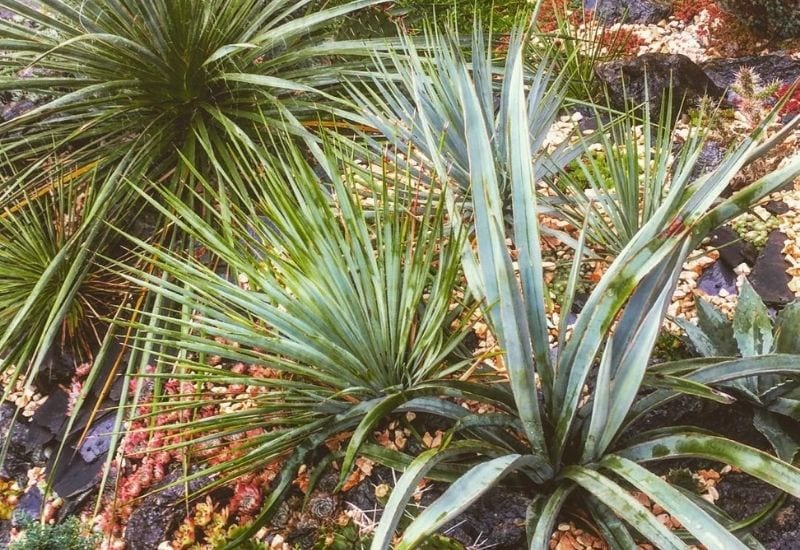
Yucca is a beautiful tall growing succulent with large rosettes of blade like, long and thin (and sharp!) leaves and massive, long lasting panicles of white and bell shaped flowers. In fact the blooms can last for months. And many of the species in this genus are very cold hardy.
For this reason, gardeners love yuccas: beautiful, generous, tough and, in many cases, even edible! But which yucca is best for you?
There are about 40 to 50 species of yuccas in the world, some are more tree like, others more shrub like.
The range goes from the large Joshua tree (up to 70 feet tall) to dwarf yucca (only 8 inches tall!) Thus, there is a range that goes from landscape planting to hedges, beds and even small spaces, like pots or small rock gardens. There are couple of varieties like Yucca guatemalensis and Yucca aloifolia which can be grown indoors as houseplants.
And to help you make the perfect choice, we have searched far and wide and found out the best yucca trees for different conditions, types of gardens and spaces.
Here are 18 popular yucca plant varieties for your landscape, along with our best tips for growing these drought-tolerant architectural plants in your garden or container.
Yucca Plant Overview
Yucca is a genus of 40 to 50 species of perennial plants, shrubs and trees native of the Americas and Caribbean islands. They are distinctive because of their sharp, sword like leaves (they actually can cut you) arranged in a rosette at the end of stems.
These stems often look woody, like trunks. But they are succulents, and succulents have no trunks as such, but stems. In fact, they are classed as shrubs, and not trees. Nevertheless, the stems often have a very upright habit, which makes them very decorative, as the ensemble looks a bit like the silhouette of a palm tree.
Where To Plant Yuccas In Garden: For this, they have a “sultry exotic look” as they are associated with dry places, like the Joshua Tree National Park in California. But they also have excellent architectural qualities. Yucca plants like arid growing conditions and they cannot stand swampy places.
Their natural areas are deserts or semi-deserts where it rains little, but also where the soil is sandy and very well drained. You will need to try to reproduce these conditions if you want healthy plants. On the other hand, the arid deserts and semi-deserts they come from also have very cold nights.
This means that yuccas are usually very hardy, they can withstand even sharp changes in temperatures and many species are actually cold hardy.
Some varieties will survive in USDA zone 5 (even 4!) and it’s not unusual to see them in the snow… I have even seen them – hold yourself – in full bloom under a coat of snow! For this reason, yuccas are different from many succulents, and gardeners love them very much.
Bloom time: They are very generous bloomers, with a huge number of long lasting flowers. Sometimes, they can bloom for virtually a whole year, including through the winter, depending on the species and conditions. The flowers are also often edible (they have a very sweet and delicate flavor, a bit like vanilla).
Soil: They are very tough plants, often very cold hardy and at the same time drought resistant and adaptable to most types of soil, as long as well drained, including infertile and poor ones. For this reason, they are very low maintenance.
And now you are about to find out what they have in common, how to grow them and how they all differ as well.
Yucca Care Factsheet
18 Types Of Yucca Plants For The Sunny Landscape
These are 18 types of yucca, all with great foliage, beautiful flowers, but also all different, large, small, wild looking or very sculptural, for all sorts of gardens:
1. Spanish Bayonet (Yucca Aloifolia)
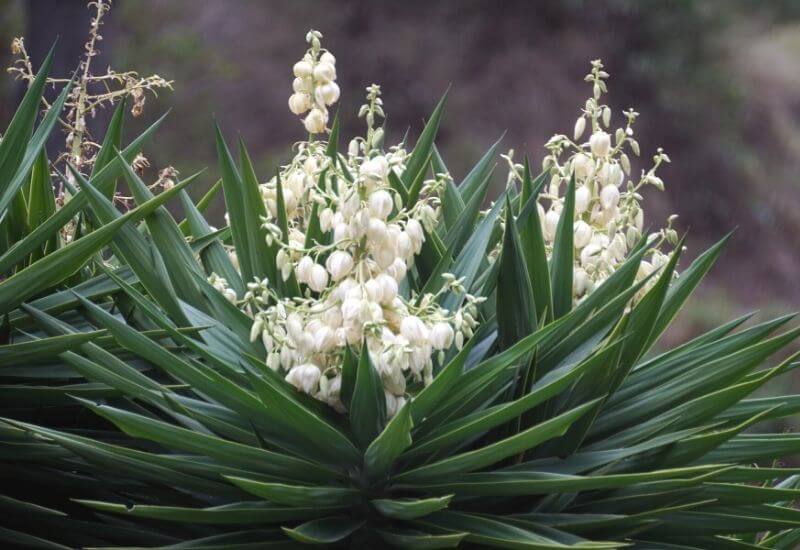
Spanish bayonet is a classical looking yucca. It has very rounded rosettes on top of light brown, grayish and tapering stems and branches that start from the base of the plant. It is very elegant and the rosettes are very dense and each leaf can be 2 feet long (60 cm). The foliage is bright green.
The flowers are white but sometimes purple, and very abundant. They start in spring, early for most yuccas, and they can last through the beginning of summer. They come on panicles that can be about 2 feet long (60 cm). This is a very elegant and architectural variety.
2. Soaptree Yucca (Yucca Elata)
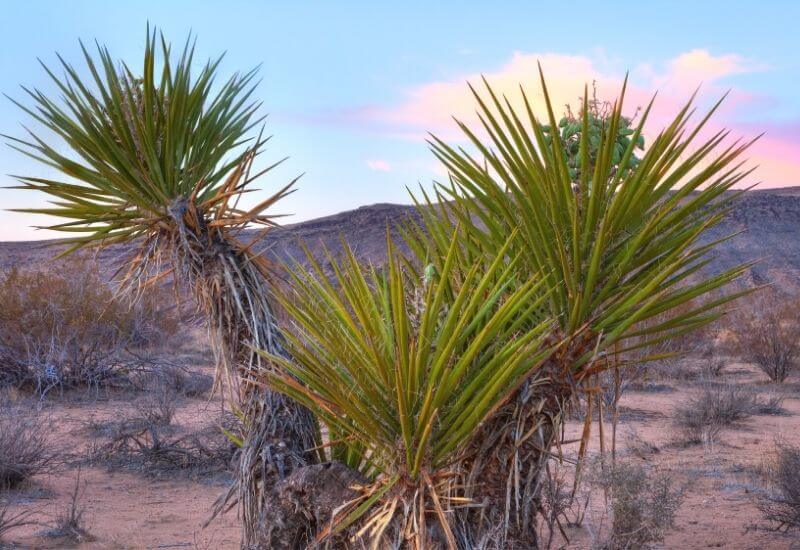
Soaptree yucca is very unusual yucca plant. It starts off as a ball of thin needles that grow close to the ground. As it grows, though, the old leaves dry out and become “the fur” of the stem, which looks very much like a palm trunk. It is very slow growing and it has very thin needles for a yucca, almost like filaments.
The flowers come on spring on along stalk (up to 6 feet, or 1.8 meters) and they are white with dashes of green or pink some times. After blooming, the plant will produce beautiful brown capsules that will last till fall. It tolerates drought as well as frost too.
3. Our Lord’s Candle (Yucca Whipplei)
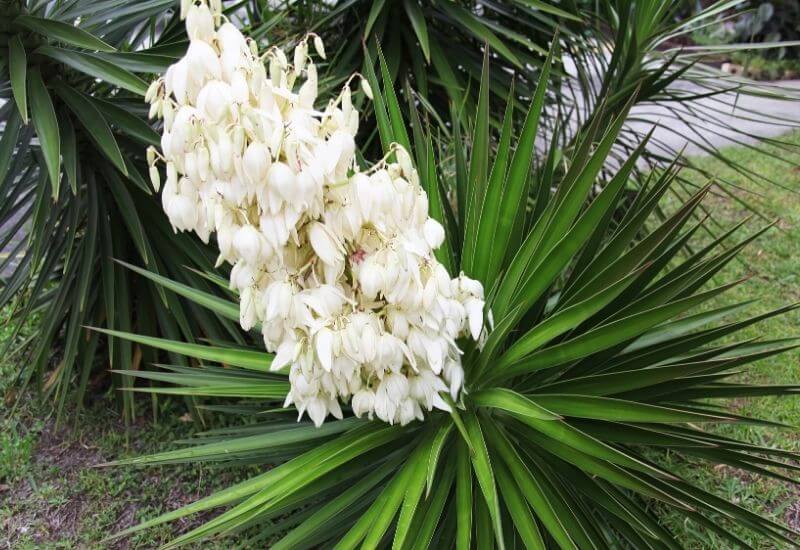
Our Lord’s candle is a very sculptural variety of yucca. The rosette of narrow bluish gray needles, with very pointed tips. The color may change with light and the tips often turn brown, adding to the effect. The rosettes grow straight on the ground.
The flowers come on a very long stalk (up to 14 feet tall, or 4.2 meters!) This will happen in summer and the panicles will be huge too, up to 3 feet long (90 cm). They have a very strong sweet scent and they are cream in color with a touch of purple. Winged capsules will follow. This plant can withstand freezing temperatures, down to 10oF (a whopping -12oC)!
4. Spineless Yucca (Yucca Elephantipes)
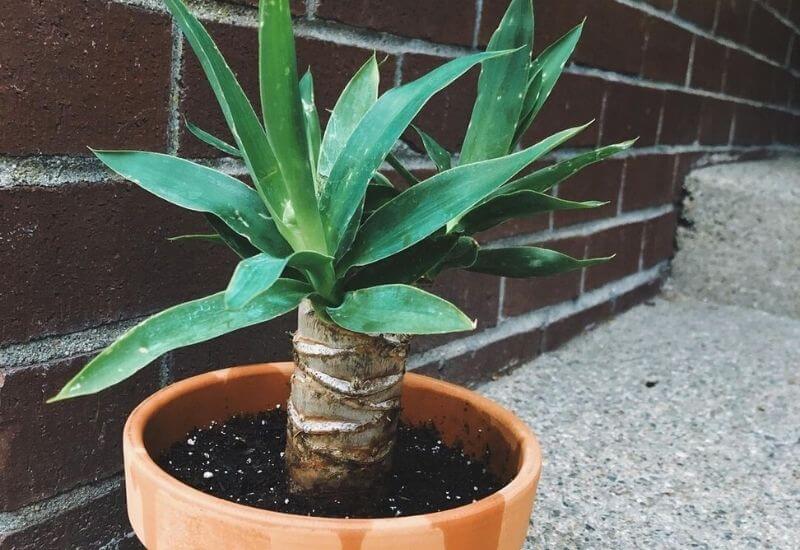
Spineless yucca is a giant variety; it can grow to 40 feet tall (9 meters), it has a large “trunk” with upright habit and many still upright branches. The rosettes are large and lush, with green to bluish green fairly broad leaves that can reach 4 feet in length (1.2 meters each). The flowers will come in summer, on a long stalk, and they are cream in color.
This variety has edible flowers, and they are actually very rich in potassium and calcium. It is also very much drought tolerant and very low maintenance. It is a winner of the prestigious Award of Garden Merit of the Royal Horticultural Society.
5. Weak Leaf Yucca (Yucca Flaccida)
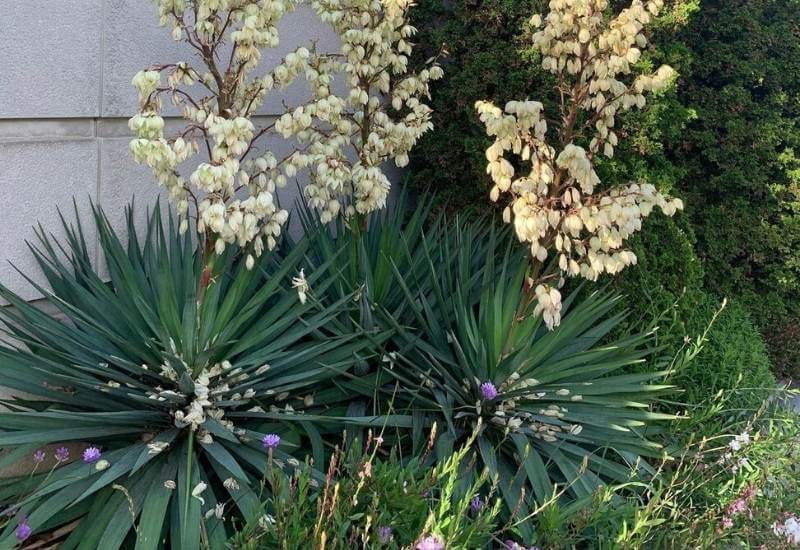
Weak leaf yucca is a small evergreen plant with rosettes that will stay close to the floor. The leaves are straight, sword shaped and pointed. They are shorter than other yuccas, reaching a maximum of 22 inches in length (55 cm). They are of a dark green color and the effect of the rosette is “bushy”.
The flowers grow on stalks that hover above the rosette. They will form many white to cream flowers, grouped in floating panicles. There are also cultivars of this yucca, notably ‘Golden Sword’ and ‘Garland Gold’. It is excellent for smaller gardens and spaces, including large containers. It is also very cold hardy.
6. Beaked Yucca (Yucca Rostrata)
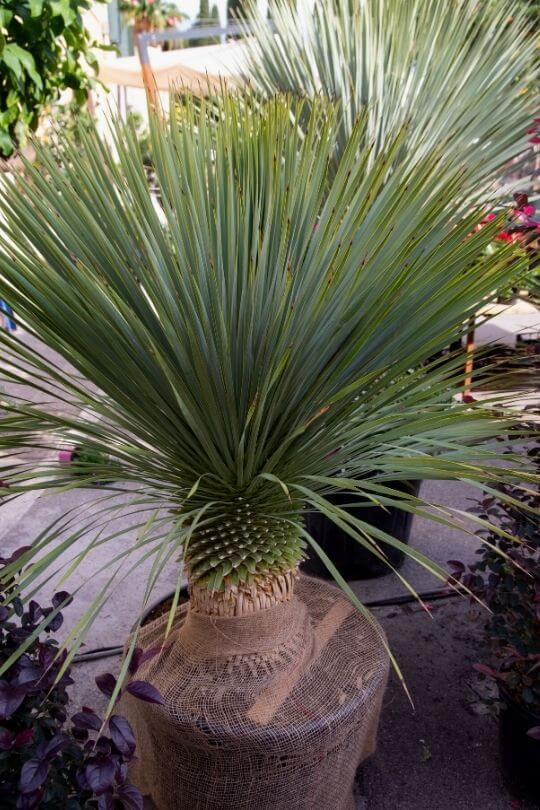
Beaked yucca is a stunning, showy tree-like type of yucca. The rosette is made up of a multitude of thin, needle like leaves of a light blue to silver color.
These have an almost “fluffy” appearance, especially as they cone on top of a single trunk like stem, which coated in the whitish (yellowish) fibers of the old leaves.
It is, basically, “the Cousin It of yuccas”. However, don’t be deceived by the look; these leaves are so sharp they can easily pierce and cut.
The flowers are white with with purple shades, and they come on large panicles every year. It is quite an early bloomer for a yucca, and it too is very cold resistant. This fluffy giant has many surprises indeed!
7. Buckley’s Yucca (Yucca Constricta)
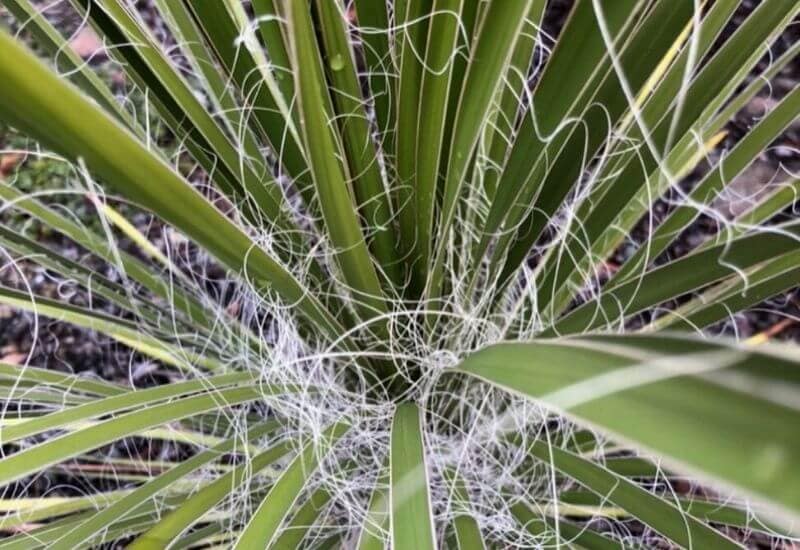
Buckley’s yucca has a different look form most yucca varieties. The rosettes tend to face upward, and they are made of many thin, hunter green to olive green needles, which do not look very orderly at all.
They grow at ground level and look a bit like tall grass. It has a “wild” look, and it lacks in the “desert and tropical” look other yuccas have.
It will also have filaments, like strings, that grow among the foliage, and this adds to its wild, rebellious look. The flowers will grow on tall panicles that look like feathers far above the foliage and they are white.
8. Twisted Yucca (Yucca Rupicola)
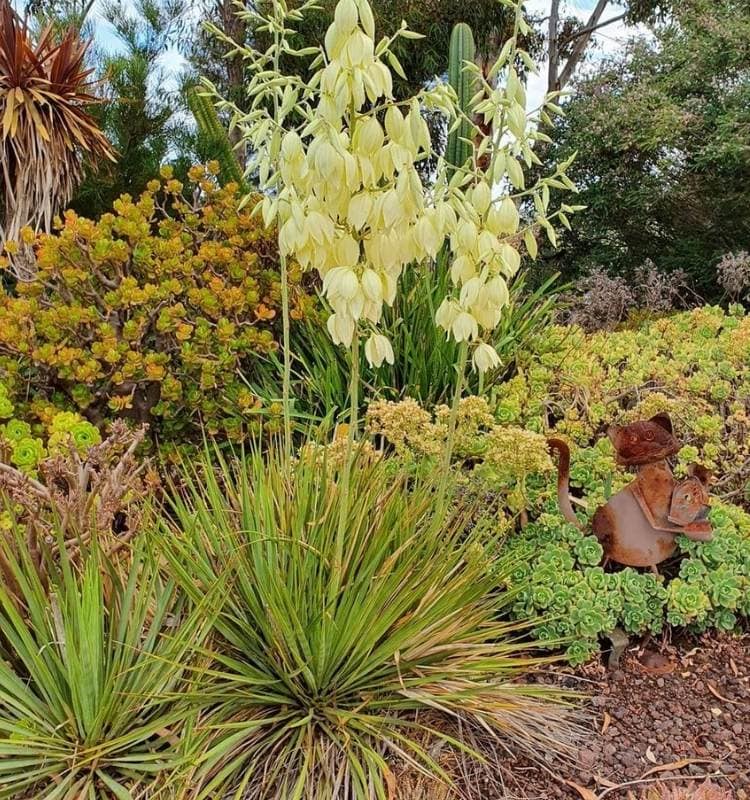
Twisted yucca is very original and decorative. It is also called Texas yucca or rock yucca. It has broad and short leaves, very bright green in color, and they are not straight. In fact, they twist. This makes the plant very sculptural and dynamic. They grow straight on the floor, with no stem, and they can come in beautiful clumps.
This is a flowering plant too, like all yuccas. The flowers come on long stalks that grow higher than the rosettes, about 5 feet tall (1.5 meters). The flowers have the classical bell shape of yucca flowers and they are white.
9. Adam’s Needle (Yucca Filamentosa)
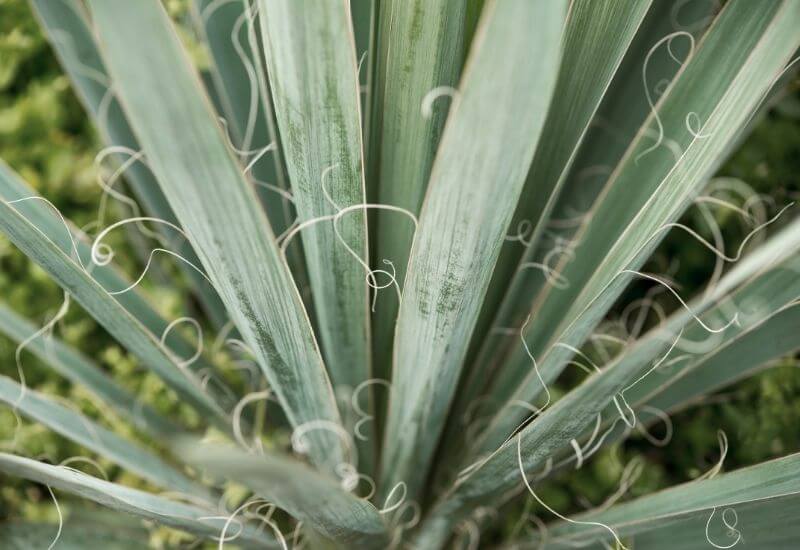
Adam’s needle is a favorite yucca with gardeners. In fact it won the Cary Award in 2012. The rosettes are very elegant, with spaced sword like leaves, and they grow at ground level, The leaves are if a bright green color, pointed and they look very stiff and fairly sculptural.
The blooms come on a stalk that grows straight from the middle of the plant, and this is where the plant gets its name. They will grow much taller than the rosettes and have lots of large and cream colored flowers, each 2.5 inches long (6 cm), which is quite a lot for yuccas.
10. ‘Color Guard’ Adam’s Needle (Yucca Filamentosa ‘Color Guard’)
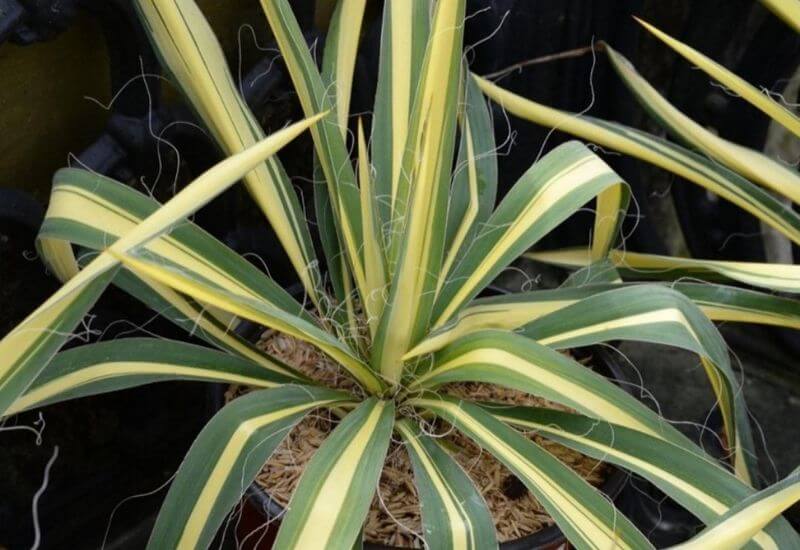
‘Color Guard’ Adam’s needle is a bright and variegated cultivar of Yucca filamentosa. It has broad and pointed leaves with stripes of green and yellow. You will understand that the effect is striking. The rosettes grow on the ground, and the effect is that of a sculptural houseplant growing in the open air with a marble surface.
This winner of the Award of Garden Merit by the Royal Horticultural Society too will grow beautiful panicles of white flowers, and quite large ones at that, as they reach 2.5 inches in length, or 6 cm. It is also one of the hardiest yuccas.
11. Spanish Dagger ‘Bright Star’ (Yucca Gloriosa ‘Bright Star’)
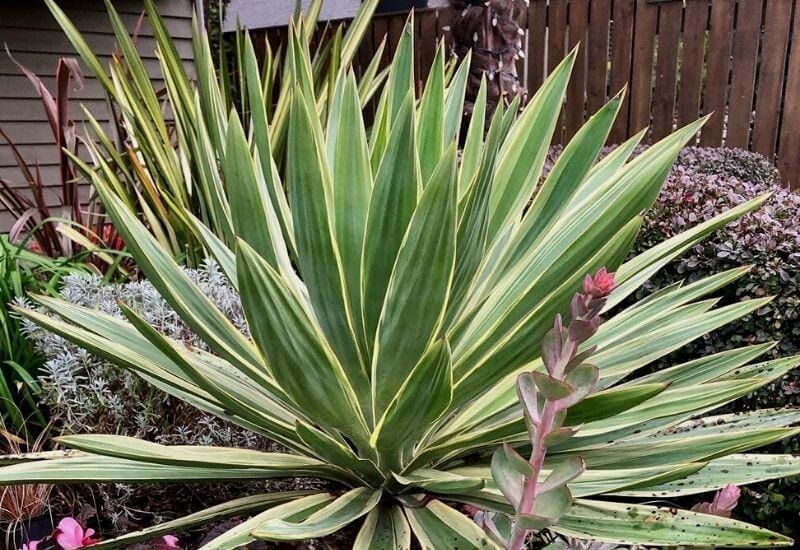
Spanish Dagger ‘Bright Star’ is a dramatic and very sculptural cultivar of Yucca gloriosa. It has very striking, decided and perfectly spherical rosettes with regular and bold leaves that grow at ground level. These are striped, usually yellow at the sides and green inside.
But with strong light, they can turn purple and cream too!The flowers too are special. They are large and spaced on the panicle, broad and white. But when they are still in bud, they are magenta purple. The effect of the two colors is actually showy and very striking too.
12. Mojave Yucca Plant (Yucca Schidigera)
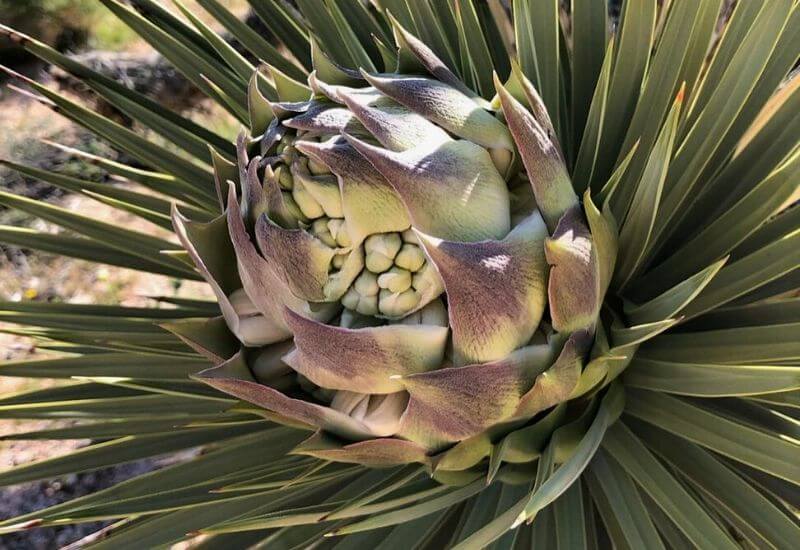
Mojave yucca plant takes its name from the desert in California and Nevada where it comes from. And it has the perfect “desert look” in fact.
It is a “tree like” shape, like Joshua trees, and a large trunk like stem, grayish brown which branches out to “hold” rosettes that look a bit like hands, or “scissor hands” to be correct.
The green, long leaves look like teeth or claws and the plant looks a bit like a man in the desert.The panicles grow straight in the middle of the rosettes, and they have white flowers with a yellow to green tint.
The flowers are super abundant and the panicles are massive, reaching 3 feet in length (90 cm) and 2 in width (60 cm)! It is also a late bloomer too.
13. Banana Yucca Plant (Yucca Baccata)
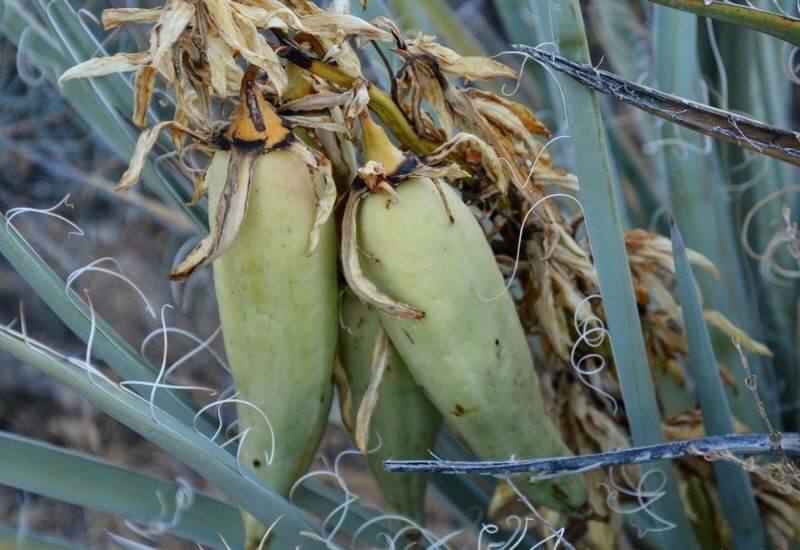
Banana yucca plant has a very, very wild, almost “alien” look. The bluish leaves look like tentacles and they grow on stalks that preserve the dried leaves, which become like dark gray filaments that drop from the rosettes.
They have the great “desert” look on them, but they also appear disheveled and unusual, like a plant you would expect on Mars.
The flowers are original too. They are large, and they look like bananas being pealed, hence the name. While the preserve the main bell shape, they have better divided petals than other yucca varieties. The outer petals are purple, the inner ones are white.
14. ‘Excalibur’ Adam’s Needle (Yucca Filamentosa ‘Excalibur’)
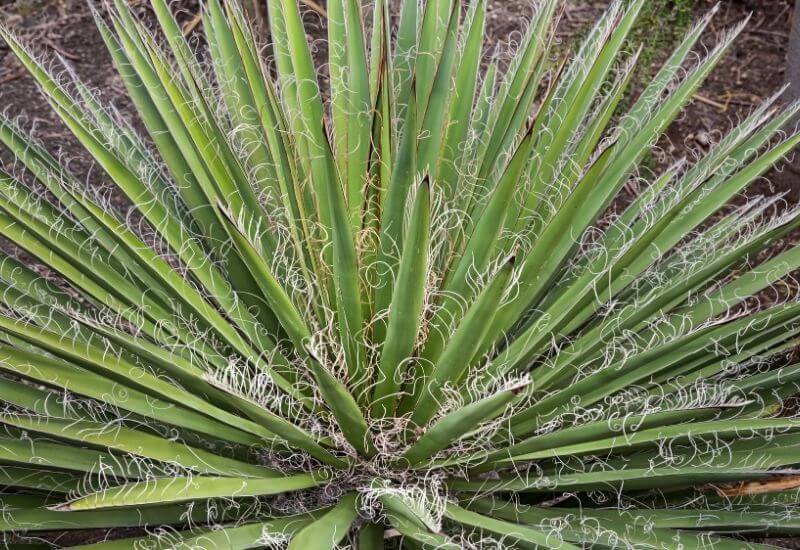
‘Excalibur’ Adam’s needle is a plastic and sculptural cultivar of yucca. It has very straight, gray blue leaves, regularly arranged in a striking rosette and with the most perfect blade shapes. They are very pointed and sharp. At the sides, there are light blue filaments that curl like metal shreds.
This plant has a very striking “industrial” look. In fact, it may look like a metal sculpture, or a sculpture you can find in a museum of industry and technology.
The flowers are large and bell shaped, and they can reach about 2.5 feet long (6 cm). They grow in tall panicles which will hover above the statuesque foliage underneath. It is also salt tolerant.
15. Dwarf Yucca (Yucca Nana, Now Renamed Yucca Harrimaniae)
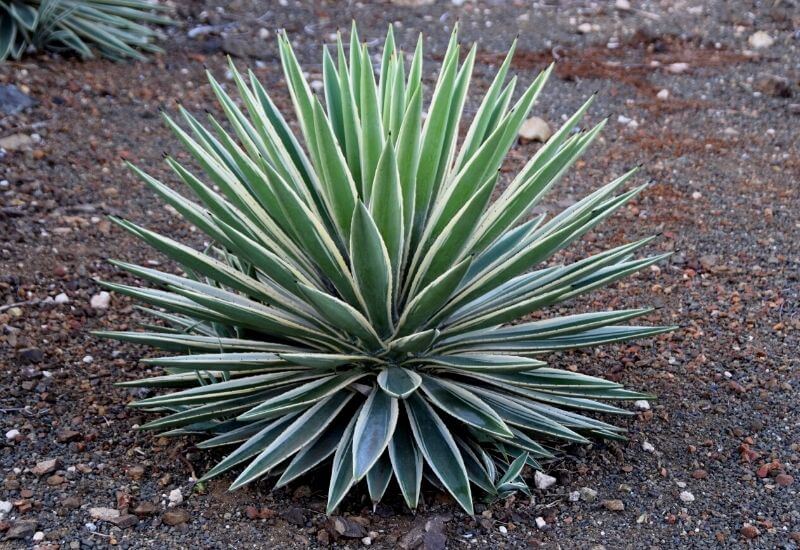
Dwarf yucca may be small, but it is very beautiful! It forms perfectly round rosettes with straight olive green to bluish green sword shaped leaves, very regularly arranged.
It looks like a little work of art, and it has delicate curly filaments at the edges of the sharp leaves. These are white and very decorative.The flowers appear in what is a spike, rather than a panicle.
It cones from the center of the plant, and the flowers are tightly packed together and placed horizontally. They are white in color and bell shaped.
16. Spanish Dagger ‘Variegata’ (Yucca Glosripsa ‘Variegata’)
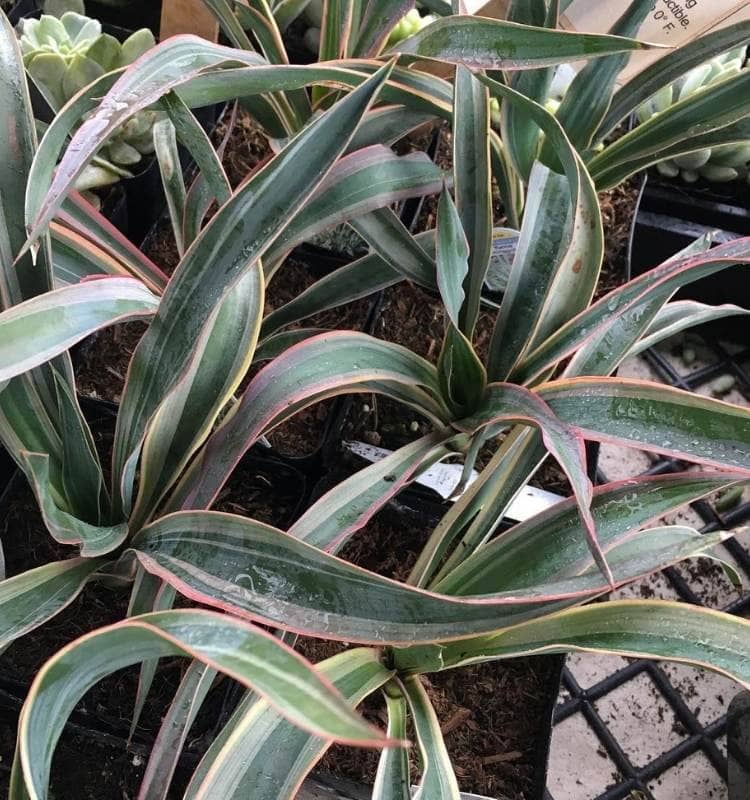
Spanish dagger ‘Variegata’ is another sculptural cultivar of yucca. It has leaves that look like Romans swords, and they cut like them! They are regularly arranged in the rosette and they are green blue with grayish cream stripes at the sides.
It is so decorative and sculptural that it won the Award of Garden Merit by the Royal Horticultural Society.The flowers of this variety of yucca are classical: they come in panicles that grow just above the foliage, they are bell shaped and their color is cream. This is a salt resistant plant too, so, it is ideal for gardens by the sea.
17. Thompson’s Yucca Plant (Yucca Thomsoniana)
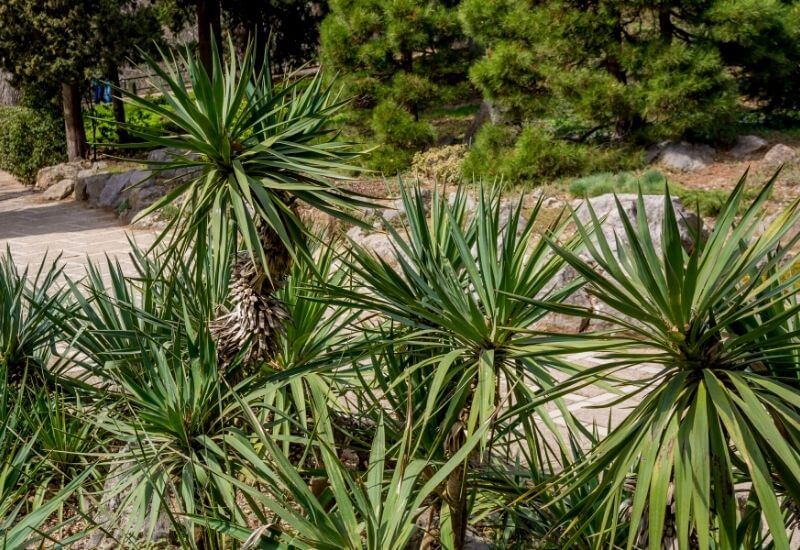
Thompson’s yucca plant looks a bit like beaked yucca, but it is smaller. It has very spherical rosettes, with sharp, thing and light silver green or silver blue leaves. The effect is that of light and airy “fans” or palm trees.
In fact, they grow on thin stems and they too preserve the old dried up foliage, like palms, which end up looking like Hawaiian skirts under the rosettes.
The stalks with panicles will grow just from the middle of the rosettes and point straight upwards, giving rich inflorescences of may cream colored and cup shaped flowers.(Yucca thonpsoniana)
18. Joshua Tree (Yucca Brevifolia)
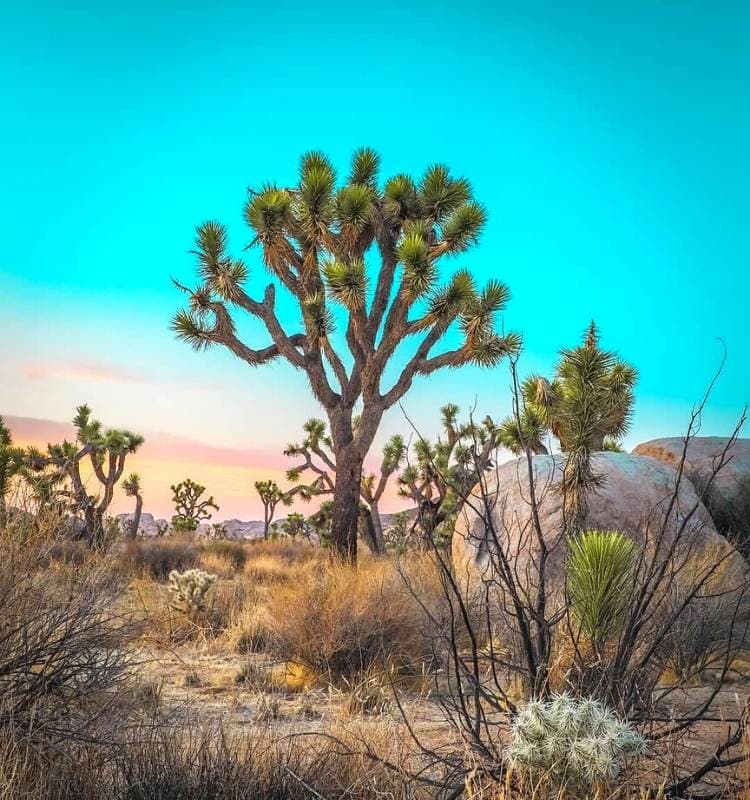
And we close with the giant of yuccas: the Joshua tree. Despite being the tallest of them all, it tales its Latin name (brevifolia) from its short leaves.
But this gives it its distinctive look, with a tall “trunk”, imposing branches still covered in the old dried foliage and… at the very end, small and compact rosettes of rapier shaped green leaves.
This look is very iconic of American deserts! The flowers come in panicle that can be 20 inches long (50 cm) at the end of the rosettes, and they are profuse and white.
However, they need a specific moth to pollinate them, called Tegeticula antithetica. It is bold statement in a garden, and one that will last, as this is a very long lived yucca: it can last for 150 years in fact!
The Perfect Desert Plant For All Sorts Of Gardens With Yucca Plants
This has been a journey in a large desert, where you can fond iconic yuccas like the Joshua tree, and more sculptural ones like Adam’s needle‘Excalibur’ or Spanish dagger ‘Variegata’, tiny dwarf yuccas and wild and alien looking ones like banana yucca. Some are giants, some fairly big, some medium sized and some tiny…
But as you can see, there are yuccas for all tastes, most types of garden and even for small containers. Now you only need to choose the one that stole your heart…

Written By
Amber Noyes
Amber Noyes was born and raised in a suburban California town, San Mateo. She holds a master’s degree in horticulture from the University of California as well as a BS in Biology from the University of San Francisco. With experience working on an organic farm, water conservation research, farmers’ markets, and plant nursery, she understands what makes plants thrive and how we can better understand the connection between microclimate and plant health. When she’s not on the land, Amber loves informing people of new ideas/things related to gardening, especially organic gardening, houseplants, and growing plants in a small space.

Really thorough & informative! This information was exactly what I needed to find.
Glad to be of help 🙂